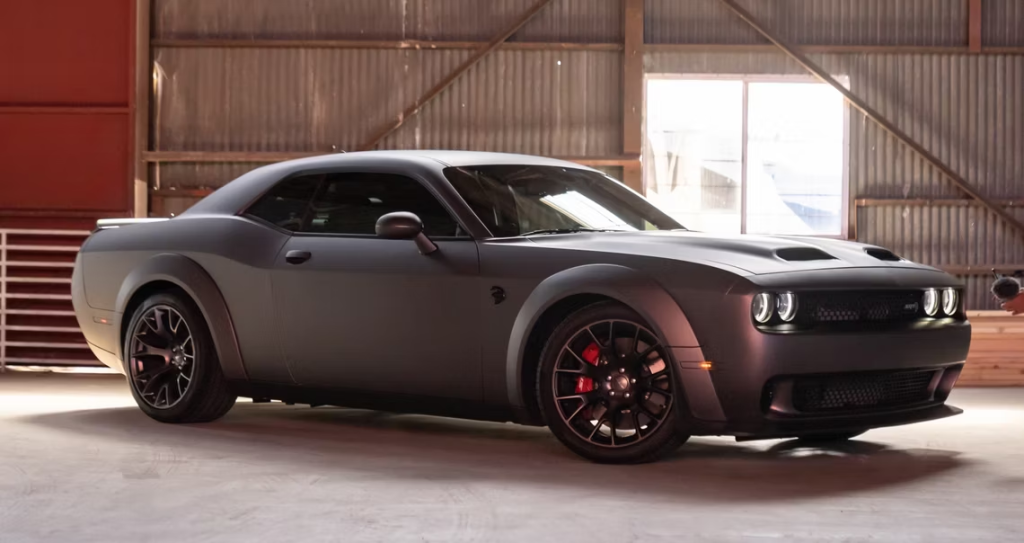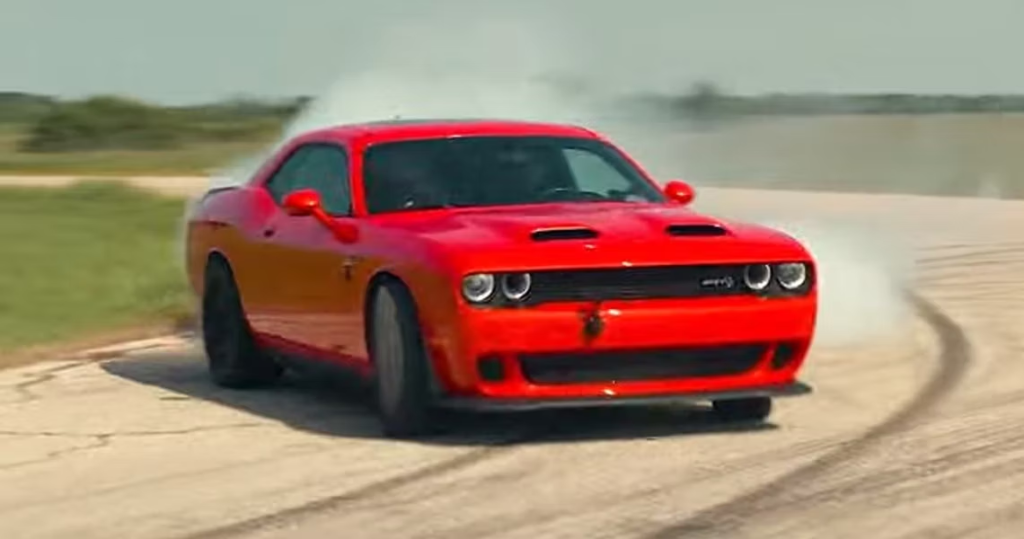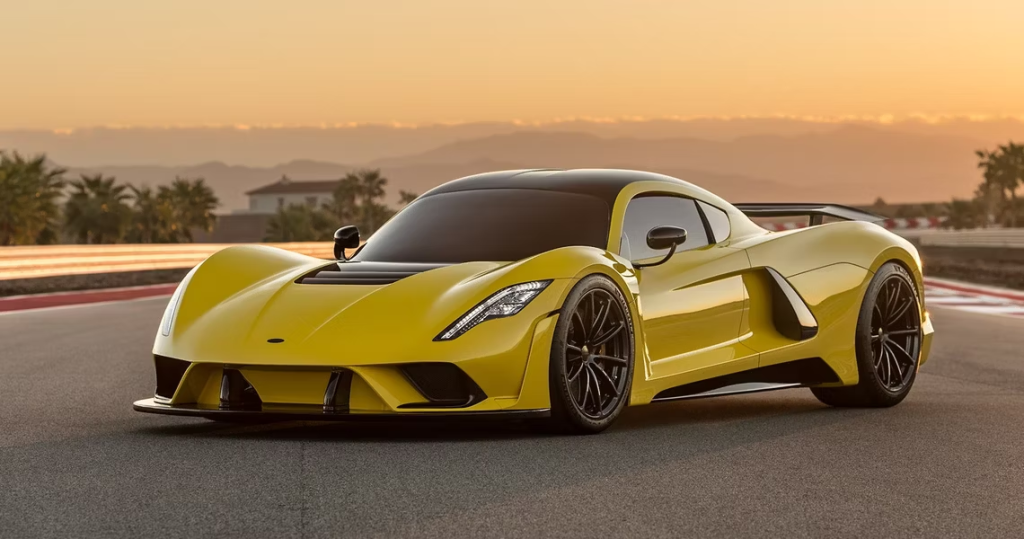Freedom Street Garage took their 2021 Dodge Challenger Hellcat to JBA Speed shop for a dyno test. Apparently, Dodge gave us the wrong figures.

In today’s parts-swapping, platform-sharing, and highly regulated automotive scene, it’s Dodge that’s deserving of a round of applause. With the automotive industry shifting towards sustainable energy, it’s companies like Dodge that really embrace what internal combustion engines are. Quite surprisingly, the fundamentals of the brand have remained largely the same, and that’s despite the emissions fiasco burdening every automaker around the globe.
The fact that Dodge is still selling a family SUV with a supercharged 6.2L V8 is quite ballsy. Add to that the gas-guzzling Charger and Challenger SRTs, and the whole lineup is nothing short of badass.
If we’re brutally honest, the Dodge Challenger is our only recommendation for hardcore muscle car enthusiasts. Frankly, the Mustang has transitioned into a mix between a sports and a muscle car, and Ford is currently milking its glorious heritage. Also, the modern Camaro is not necessarily a true muscle car either.
The Challenger SRT Hellcat is, without a shadow of a doubt, the last great muscle car sold in America. But what left us surprised is how Dodge lied about the Hellcat’s horsepower figures. Freedom Street Garage took their 2021 Hellcat to JBA Speed shop and put it on the dyno. Surprise, surprise, the car made more power than advertised!
Let’s Take A Closer Look At FSG’s $100,000+ Challenger Hellcat Widebody

What you find under the hood is a 6.2L supercharged Hemi putting out a whopping 717 horsepower and 656 lb-ft of torque. At least, that’s what Dodge says. More on that soon. For something that handles like a boat, the Challenger Hellcat—despite its aging platform—is still a force to be reckoned with. If you ever doubted the Hellcat’s purpose, think of this—the speed machine is supplied with a 2.4L supercharger, which is about the size of most mainstream car engines.
Dodge equips the Hellcat with Bilstein active suspension, in addition to six-piston front and four-piston rear Brembo brakes. The supercharged Hemi sends power to the rear wheels via an 8-speed automatic, with a limited-slip differential thrown in for better traction. You could’ve ordered a Hellcat with a 6-speed manual, but 2022 Challenger Hellcats are strictly an 8-speed torque converter only. Apparently, this is a temporary measure, and the six-speed manual should return at some point with a revised calibration.

FSG’s Hellcat costs over $100,000. Has the widebody package, which adds $6,000 to the Hellcat’s $61,000 base price. Comes with the optional $2,000 plus package, giving you ventilated seats and suede inserts. Additionally, the Hellcat is optioned with the $1,000 Alcantara package and the SRT logo embroidered on the seats. It also has the near-$2,000 Harman Kardon 18-speaker premium audio and the U-connect 8.4-inch touchscreen with Apple CarPlay and Android Auto.
This Hellcat gets the 8-speed auto, adding another $3,000 on top of the $1,200 granite-finish 20-inch wheels wrapped in 305-section high-performance rubber. All told, the car sits at $83,000. But after factoring in the taxes, dealer markups, the custom gun-metal wrap, and ceramic coating, total price rockets past $100,000.
The 2021 Challenger Hellcat Makes More Than 717 Horsepower At The Crank
FSG’s Challenger Hellcat, after the dyno run, puts out 748 horsepower at the crank. What this means is, Dodge has undervalued the Hellcat by advertising it at 717 horsepower. Also, if we look at the dyno map, the Hellcat puts out 563 whp (wheel horsepower), while torque figures are 521 lb-ft. This equates to a 25 percent drivetrain loss, which is something you have to live with. However, the 190-odd horsepower loss could’ve been minimized if it was a manual.
That said, automatics are getting more efficient. And, the 25 percent loss seems a bit high. Owners over at Hellcat.org claim 620-640 whp. Also, they estimate drivetrain loss to be around 15 to 20 percent, which makes sense given it’s a fairly modern gearbox. Then again, a dyno is a tool with many variables. Air temperatures can affect the output, as does altitude. Too hot an intake—you’ll be down on power; the colder, the better. Fuel used also makes a difference. Higher octane fuel can deliver better results.
Another inference from the JBA dyno run is that a Mustang dynamometer is used for the test. Forum members claim Dynojet being slightly more accurate, bringing us back to the idea of a dyno being just a tool. Use it for reference when modifying the internals or running a tune. Numbers make sense only if you’re using them at full potential. Nine out of ten people are using their Hellcat as a recreational item. Surely, no one’s hitting the strip every day. So instead of worrying about numbers, try enjoying it. And since it’s a Hellcat, we’re pretty certain you won’t be disappointed.
Sources: Freedom Street Garage, Hellcat Forum
A Dodge Challenger Hellcat With A Manual And 1,000 HP Is American Muscle Car Perfection
Hennessey’s HPE1000 performance upgrade for the Hellcat makes an already amazing car a whole lot better.

Stellantis will stop producing the Dodge Challenger and Charger after the 2023 model year. But that does not mean that Dodge will cease to be a brand that focuses on selling muscle cars. There will be an all-new Dodge muscle car arriving soon, but this one will not have a HEMI or a Hellcat engine. Instead, it will be an electric vehicle.
There is a likelihood that the new Dodge EV muscle car can put out more horsepower than the vaunted HEMI or Hellcat engines. It is also possible that the EV will be faster than any Hellcat-powered Dodge Challenger or Charger.
But there is one thing that an EV cannot do. No matter how powerful or fast an EV might be, it will never emit as sweet of a sound as an internal combustion engine. The sound coming from an ICE at WOT, or when rowing through the gears is a sound that will be greatly missed when EVs take over the roads and racetracks.
One of the best-sounding cars is the Hennessey Dodge Challenger Hellcat. You can see and hear it in action in a video that Hennessey Performance has posted on their YouTube Channel.
Hennessey Makes The Challenger Hellcat Even More Ferocious
The Dodge Challenger Hellcat sounds and drives like a beast straight from the factory. But Hennessey Performance makes some adjustments that make this muscle car into an even more ferocious animal.
Thanks to engine mods including an upgraded supercharger, the HPE1000 Hellcat puts out an astounding 1000 hp and 948 lb-ft of torque. This all gets sent to the rear wheels by a six-speed manual transmission.
The headers and upgraded supercharger also enable the engine the sound even more visceral than the stock unit. The sound of the engine during gear changes is especially melodious. It is also a sad reminder that ICEs and manual transmissions are also becoming extinct in the near future.
Watch And Listen To The HPE Hellcat On A Road Course

The video shows the HPE1000 Hellcat Challenger going through the motions on a road course. There is the requisite wheelspin and tire smoke that comes with any rear-wheel-drive car with a Hellcat motor.
The driver shifts through the gears as the car maneuvers around the course while beautiful sounds come from the engine and exhaust. This is something that no EV can or will ever replicate.
Hennessey Vows To Beat 300+ MPH Bugatti Chiron With Upcoming Hypercar
John Hennessey has vowed to defeat the Bugatti Chiron that broke the 300 mph barrier with his upcoming F5 hypercar.

John Hennessey, the founder of Hennessey Performance, has vowed to beat Bugatti’s 304-mph Chiron with the upcoming Venom F5 hypercar.
Earlier this week, Bugatti stunned the world by revealing a prototype Chiron that managed to break the 300 mph barrier. At Volkswagen’s Ehra-Lessien, driver Andy Wallace reached a top speed of 304.77 mph.
It was a momentous occasion and one that will certainly go down in history as the first production car to exceed 300 mph. It was also quickly followed-up by a statement from Bugatti president Stephan Winkelman saying that the French carmaker would stop chasing top speed records and that if VW hadn’t tied their hands to a German test track they could have gone even faster.
John Hennessey, speed and power aficionado extraordinaire, had some criticism for Bugatti’s record-breaking performance, not the least of which being that the final top speed figure was a single run in a single direction.
“I’m surprised Bugatti did not run both directions,” Hennessey told Top Gear in an interview. By only running in a single direction for their top speed run, Bugatti invalidated their chance to be recorded in the Guinness Book of World Records, which requires any top speed dash to be done in two directions, with an average speed taken between each run.
Previous record-breaking attempts were done in this way as an industry agreed-upon standard of making top speed record attempts. Koenigsegg did it in 2017 with the Agera and even Bugatti themselves did it in 2010 with the Veyron.
Bugatti has explained that the Ehra-Lessien test track has a certain directional grain in the asphalt, and going against it in the opposite direction was seen as too dangerous to the experimental Michelin tires.
Hennessey also said he believes Bugatti was low-balling the Chiron’s power figures. “I’m really intrigued by how much horsepower Bugatti’s engine was really making on the run. To run 40+ mph faster than the Chiron Sport that TG tested on the same track would take a lot more than a 100 hp bump, lowered suspension and some rear aero adjustments. We’re guessing that their one-off Chiron was pushing closer to 2,000 hp.”
With typical Hennessey bravado, he then vowed to defeat Bugatti at their own game with the upcoming Venom F5 hypercar. “F5 will be at least 450kg lighter than the Chiron and will have more power than they are claiming. We can beat it and have a couple of highways in the USA where we think we would have enough room to hit our absolute top speed, but we would prefer to do this in Texas if possible.”
You can read the whole interview over on Top Gear.




















